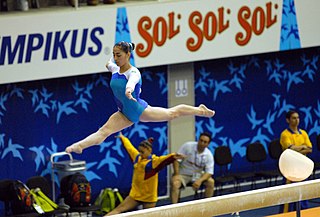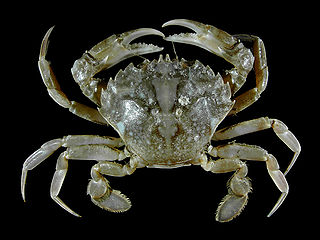
Calisthenics is a form of exercise consisting of a variety of gross motor movements—running, standing, grasping, pushing, etc.—often performed rhythmically and with minimal equipment, as bodyweight exercises. They are intended to increase strength, fitness and flexibility, through movements such as pulling, pushing, bending, jumping, or swinging, using one's bodyweight for resistance. Calisthenics can provide the benefits of muscular and aerobic conditioning, in addition to improving psychomotor skills such as balance, agility and coordination.
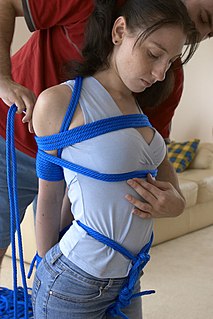
Over the course of BDSM activities, a number of bondage positions and methods may be used. Ropes are the most common elements of these positions, although straps, webbing, chains, hooks, manacles, spreader bars, collars, various gags and monogloves may also be used.
A suplex is an offensive move used in both professional and amateur wrestling. It is a throw that involves lifting the opponent and bridging or rolling to slam the opponent on their back.

A handstand is the act of supporting the body in a stable, inverted vertical position by balancing on the hands. In a basic handstand the body is held straight with arms and legs fully extended, with hands spaced approximately shoulder-width apart and the legs together. There are many variations of handstands, all of which require the performer to possess adequate balance and upper body strength. A athlete must always keep their butt and core tight and have their head in.

The bridge is an exercise. Many variations of this exercise are employed throughout the world, most commonly the balancing of the body on the head/shoulders and the feet. Hands are occasionally used instead of or along with the head. It is intended to improve lower back and gluteus strength. Examples of bridging in sportive or self-defense applications are seen in Kung Fu, Judo, Brazilian jiu jitsu, Capoeira, mixed martial arts, and wrestling.
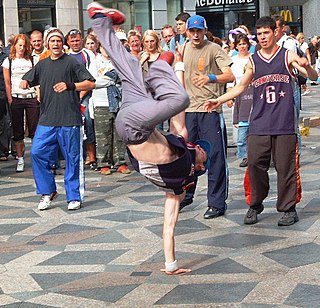
A freeze is a b-boying technique that involves halting all body motion, often in an interesting or balance-intensive position. It is implied that the position is hit and held from motion as if freezing in motion, or into ice. Freezes often incorporate various twists and distortions of the body into stylish and often difficult positions.
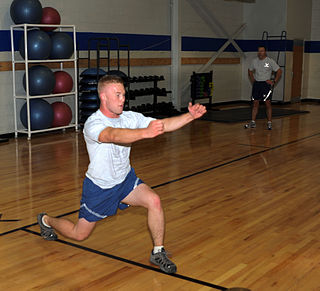
A lunge can refer to any position of the human body where one leg is positioned forward with knee bent and foot flat on the ground while the other leg is positioned behind. It is used by athletes in cross-training for sports, by weight-trainers as a fitness exercise, and by yogis as part of an asana regimen.

Sarvangasana] or Shoulderstand, or more fully Salamba Sarvangasana], is an inverted asana in hatha yoga.
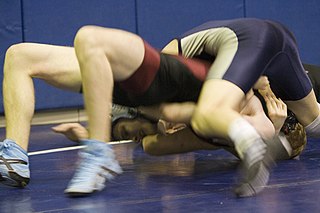
The bridge is a grappling move performed from a supine position, lying down face-up. It involves lifting the pelvis off the ground so that the body weight is supported on the shoulders at one end and on the feet at the other. This move is used in wrestling and other grappling and groundfighting sports, often combined with a twisting motion, to dislodge or flip an opponent who has established a position on top. The bridge is also a common exercise position. This maneuver can also be used to dodge pin attempts.

Chaturanga Dandasana or Four-Limbed Staff Pose, also known as Low Plank, is an asana in modern yoga, in which a straight body parallel to the ground is supported by the toes and palms, with elbows at a right angle.

Matsyendrasana, Matsyendra's Pose or Lord of the Fishes Pose, is a seated twisting asana in hatha yoga. The full form is the difficult Paripurna Matsyendrasana. A common and easier variant is Ardha Matsyendrasana. The asana usually appears as a seated spinal twist with many variations, and in its half form is one of the twelve basic asanas in many systems of hatha yoga.
A roll is the most basic and fundamental skill in gymnastics class. There are many variations in the skill. Rolls are similar to flips in the fact that they are a complete rotation of the body, but the rotation of the roll is usually made on the ground while a flip is made in the air with the hips passing over the head and without any hands touching the ground. Rolls also help recover from a fall safely.

The plank is an isometric core strength exercise that involves maintaining a position similar to a push-up for the maximum possible time.

Mālāsana, is a term for various squatting āsanas in hatha yoga.
Forrest Yoga is a style of modern yoga. It was created by and named for Ana T. Forrest, an American yogini. It is known for "its long holding of positions, emphasis on abdominal core work, and standing series that can go on for 20 poses on each side". Reputed for its intensity, the style emphasizes connecting to one's feelings in order to work through physical and emotional trauma.
Hasta Vinyasas are a set of yoga vinyāsas which primarily involve movement of the arms.

Navasana, Naukasana, Boat Pose, or Paripurna Navasana is a seated asana in modern yoga.

Virabhadrasana or Warrior Pose is a group of related lunging asanas in hatha yoga commemorating the exploits of a mythical warrior, Virabhadra.
Setu Bandha Sarvāṅgāsana, Shoulder supported bridge or simply Bridge is an inverted back-bending asana in hatha yoga.
Jaṭhara Parivartanāsana, Revolved Abdomen Pose, Belly Twist, or Spinal Twist is a reclining twist asana in modern yoga.
